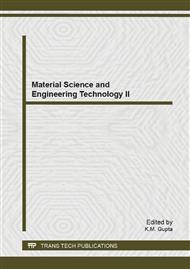p.220
p.226
p.231
p.236
p.241
p.246
p.251
p.257
p.262
Analysis and Quantification of Grain Size of Various DHP Copper Tubes Manufacturing Processes
Abstract:
Deoxidized High Phosphorus (DHP) Copper tubes are frequently used in numerous industrial and household applications. To ensure the acceptability of DHP copper tubes prepared by various industrial processes, the quality of the DHP copper tubes must be evaluated and one of the best ways to do so is to examine the microstructure and metallography and quantify grain size. In this paper the authors considered the average grain size of copper tube samples made traditionally as well as by the planetary rolling and CastTube process. Because of the small thickness of the CastTube samples, in certain circumstances traditional methods of grain counting were not plausible and a new procedure for grain counting needed developed. This paper is about the development and evaluation of grain sizes in continuously cast tube samples using both the planimetric procedure (ASTM E112) and a new method, which will be herby, referred to as the total grain counting method. This paper also concludes that there is a large difference in the grain size of tubes with different manufacturing methods.
Info:
Periodical:
Pages:
241-245
Citation:
Online since:
December 2013
Price:
Сopyright:
© 2014 Trans Tech Publications Ltd. All Rights Reserved
Share:
Citation:


